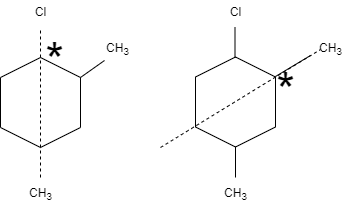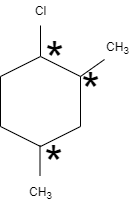
How many chiral carbon atoms are there in \[1-\] chloro \[-2,5-\] dimethyl cyclohexane?
A. $3$
B. $1$
C. $2$
D. $0$
Answer
560.7k+ views
Hint: Chiral compounds are the compounds that cannot be superimposed on its mirror image by the combination of rotation. Chiral compounds exist in two isomers that show mirror images of each other. These are also enantiomers.
Complete answer:
Before talking about the answer, we should know what a chiral molecule is. A chiral molecule consists of a chiral center. When this center coincides with another atom, that substance is said to have point chirality. A compound is said to be chiral when there is no plane of symmetry and center of symmetry. If it does not have either of these, then it is said to be chiral.
Plane of symmetry is defined as a plane that divides a molecule in two halves that shows mirror images of each other.
In this question, \[1-\] chloro \[-2,5-\] dimethyl cyclohexane has two planes of separation, that means, the either side of the plane is different with carbon having different groups. One chiral carbon atom is attached with chlorine, the second chiral carbon is attached to methyl group and the third chiral carbon atom is attached with methyl group that does not contain any neighbor groups.


Therefore, \[1-\] chloro \[-2,5-\] dimethyl cyclohexane contains three chiral carbon atoms.
Hence, the correct option is (A) $3$
Additional information:
-As we have discussed that chiral compounds are the compounds that do not show superimposable mirror images, whereas achiral compounds are the compounds that show superimposable mirror images of each other.
-Chiral compounds do not show planes of symmetry or center of symmetry, whereas achiral compounds show planes of symmetry or center of symmetry.
Note: Center of symmetry is defined as a point from where if we move towards a group, it shows equal distance when we move in the opposite direction of the equivalent group.
A molecule shows a center of symmetry only when identical atoms exist in that molecule.
Complete answer:
Before talking about the answer, we should know what a chiral molecule is. A chiral molecule consists of a chiral center. When this center coincides with another atom, that substance is said to have point chirality. A compound is said to be chiral when there is no plane of symmetry and center of symmetry. If it does not have either of these, then it is said to be chiral.
Plane of symmetry is defined as a plane that divides a molecule in two halves that shows mirror images of each other.
In this question, \[1-\] chloro \[-2,5-\] dimethyl cyclohexane has two planes of separation, that means, the either side of the plane is different with carbon having different groups. One chiral carbon atom is attached with chlorine, the second chiral carbon is attached to methyl group and the third chiral carbon atom is attached with methyl group that does not contain any neighbor groups.


Therefore, \[1-\] chloro \[-2,5-\] dimethyl cyclohexane contains three chiral carbon atoms.
Hence, the correct option is (A) $3$
Additional information:
-As we have discussed that chiral compounds are the compounds that do not show superimposable mirror images, whereas achiral compounds are the compounds that show superimposable mirror images of each other.
-Chiral compounds do not show planes of symmetry or center of symmetry, whereas achiral compounds show planes of symmetry or center of symmetry.
Note: Center of symmetry is defined as a point from where if we move towards a group, it shows equal distance when we move in the opposite direction of the equivalent group.
A molecule shows a center of symmetry only when identical atoms exist in that molecule.
Recently Updated Pages
A man running at a speed 5 ms is viewed in the side class 12 physics CBSE

State and explain Hardy Weinbergs Principle class 12 biology CBSE

Which of the following statements is wrong a Amnion class 12 biology CBSE

Two Planoconcave lenses 1 and 2 of glass of refractive class 12 physics CBSE

The compound 2 methyl 2 butene on reaction with NaIO4 class 12 chemistry CBSE

Bacterial cell wall is made up of A Cellulose B Hemicellulose class 12 biology CBSE

Trending doubts
What are the major means of transport Explain each class 12 social science CBSE

Which are the Top 10 Largest Countries of the World?

Explain sex determination in humans with line diag class 12 biology CBSE

Draw a labelled sketch of the human eye class 12 physics CBSE

How much time does it take to bleed after eating p class 12 biology CBSE

Suicide bags of cells are aEndoplasmic reticulum bLysosome class 12 biology CBSE




